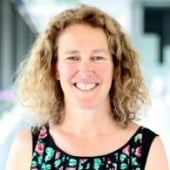

Seaweeds for Carbon Dioxide Removal and Carbon Sequestration: Challenges of Monitoring, Reporting and Verification
Catriona L. Hurd, Professor of Seaweed, Institute for Marine and Antarctic Studies, Australia
About the speaker:
Catriona L. Hurd is an eco-phycologist with expertise in the physiological responses of seaweeds to environmental drivers including light, temperature, water motion, dissolved inorganic carbon and nutrient supply. Her research currently focusses on the impacts of ocean acidification, ocean warming and marine heat waves on seaweed metabolism, the development of seaweed aquaculture in Australia, and on assessing the role of seaweeds in marine Carbon Dioxide Removal and carbon sequestration.
Catriona graduated in 1990 with a PhD in seaweed eco-phsyiology from Queen’s University of Belfast, UK. She moved to Canada in 1991, where she was a postdoctoral fellow in the Department of Oceanography, University of British Columbia, and then took up a permanent academic position at the University of Otago, New Zealand (1995-2013). In 2013, she relocated to the Institute for Marine and Antarctic Studies, University of Tasmania, Australia where she currently works. Catriona has published > 150 papers that have been cited > 13,000 times, and graduated > 100 Honours/MSc/PhD students in seaweed ecology and physiology. She led the second edition of the highly respected text-book Seaweed Ecology and Physiology (2014) which won the 2015 Phycological Society of America Gerald Prescott award.
Organisation:
The Institute for Marine and Antarctic Studies (IMAS) at the University of Tasmania is internationally recognised for excellence in marine and Antarctic research.
Located on the Hobart waterfront, their IMAS headquarters houses world-class laboratories and teaching spaces, and cultivate new research and educational opportunities. They share this landmark building with important research partnerships, including Australia’s Integrated Marine Observing System (IMOS), the Australian Antarctic Program Partnership (AAPP), the Australian Centre for Antarctic Science (ACEAS) and more.
Just 15 minutes away on the scenic route south, IMAS Taroona is emerging as a unique fisheries and aquaculture precinct – a centre for world-class research, enhanced collaboration and industry engagement, and outstanding marine science education. At the heart of the Taroona facility is the Joint Venture Agreement between the State Government and the University - Sustainable Marine Research Collaboration Agreement (SMRCA).
At IMAS, they create exceptional learning opportunities for the next generation of scientists, industry and Government leaders, and they are dedicated to enhancing environmental understanding and informing thoughtful and sustainable development for the benefit of Australia and the world.
Presentation
Seaweeds are an extremely important marine resource in coastal systems globally, with substantial potential for human food, feed additives, methane reduction from ruminants and novel products. Increasing seaweed stocks, particularly via aquaculture including into the open ocean, has been widely promoted as a natural, safe and simple solution to climate change via the photosynthetic fixation of atmospheric carbon dioxide and the subsequent sequestration of carbon as living biomass or into sediments. However, the optimism and enthusiasm afforded by seaweed ‘afforestation’ for carbon dioxide removal (CDR) is not currently supported by underpinning science. In this talk, I outline best scientific practice required to Monitor, Report and Verify (MRV) the quantity of carbon dioxide that was removed from the atmsophere by seaweeds (natural or aquacultured), and then permantly stored on time-scales relevant to carbon sequestraiotn (i.e. > 100 years). I also highlight other, more tractable, methods by which seaweeds might assist in climate mitigation.

